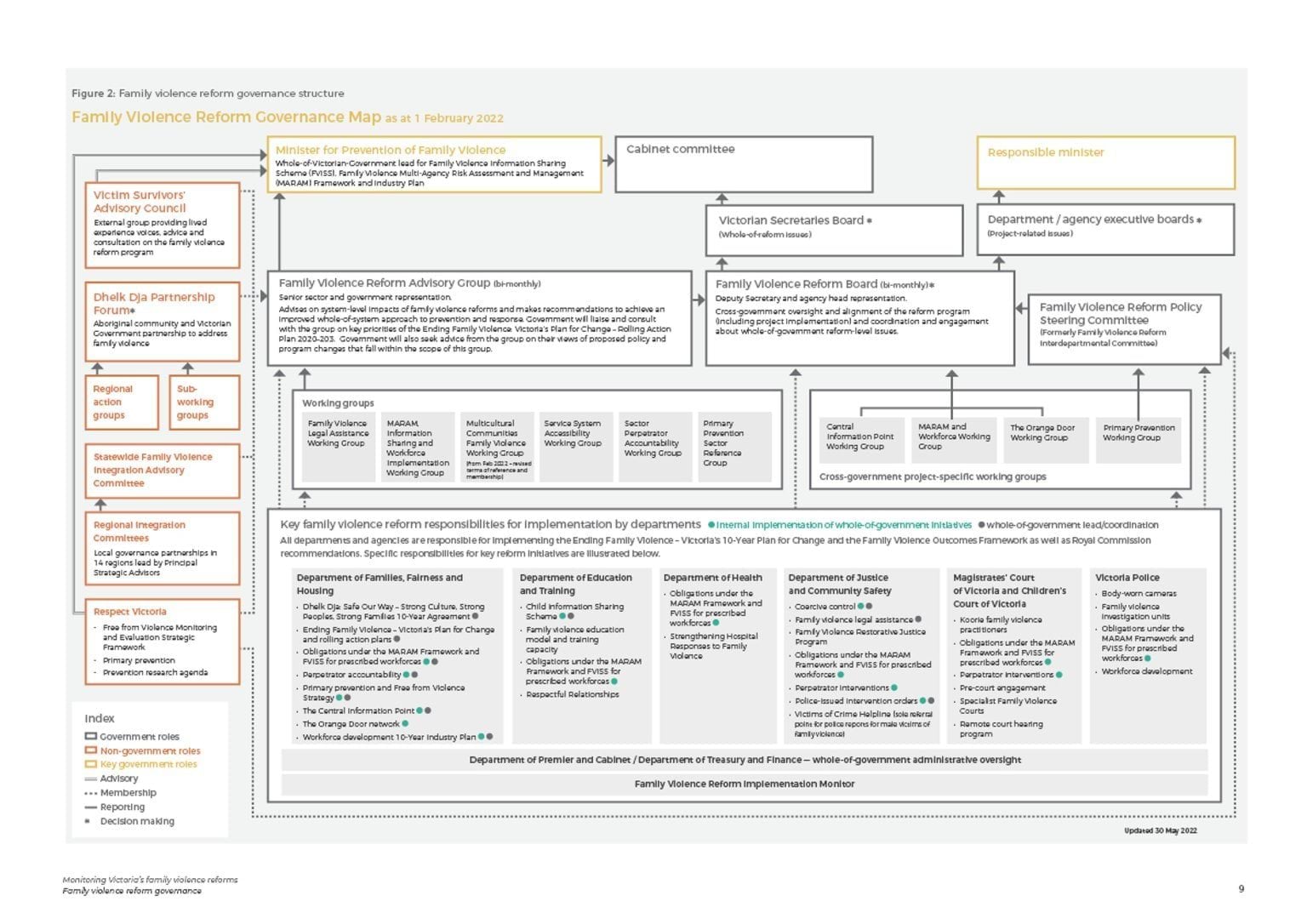The Royal Commission into Family Violence found that despite a growing focus on family violence and the establishment of structures to ensure coordination and integration, there remained a lack of accountability, collective ownership and oversight for the family violence system. Governance was identified by the Royal Commission as a key system limitation:
'The Victorian Government does not have a dedicated governance mechanism in place to coordinate the system’s efforts to prevent and respond to family violence or to enable an assessment of the efficacy of current efforts.'1
The Royal Commission made 10 recommendations relating to sustainable and certain governance (recommendations 193 to 202) that set out a range of structures and functions to be put in place to implement the Commission’s recommendations and oversee systemic improvements in the family violence system.
In particular, recommendation 193 required the Victorian Government to establish a governance structure consisting of:
- a bipartisan standing parliamentary committee on family violence
- a Cabinet standing sub-committee chaired by the Premier of Victoria
- a family violence unit located in the Department of Premier and Cabinet
- a Statewide Family Violence Advisory Committee
- Family Violence Regional Integration Committees, supported by Regional Integration Coordinators
- an independent Family Violence Agency established by statute.
Early reform-wide governance arrangements
Following the Royal Commission, the Victorian Government progressively established or strengthened a range of governance bodies to inform and oversee implementation of the reform program. These included:
- a coordinating unit within the Department of Premier and Cabinet, established in 2017 to lead coordination and reporting for the Victorian Government’s response to the 227 recommendations of the Royal Commission’s report, and to provide advice to the Premier, the Cabinet sub-committee and the family violence sub-committee of the Victorian Secretaries Board2
- an interdepartmental committee, established in February 2018 to provide whole-of-reform governance with responsibility for making decisions and managing interdependencies, sequencing, and risks, and escalating matters to the Victorian Secretaries Board sub-committee3
- creation of Family Safety Victoria (as an administrative office of the then Department of Health and Human Services rather than by statute) in July 2017 to lead the delivery of many of the government’s key family violence reform initiatives, including the 17 The Orange Door sites across Victoria, MARAM, Family Violence Information Sharing Scheme and Central Information Point.4 Family Safety Victoria is also responsible for establishing the Centre for Workforce Excellence and leading the Family Violence Industry Plan to build workforce capacity and capability in partnership with the sector5
- a family violence sub-committee of the Victorian Secretaries Board
- a Family Violence Steering Committee consisting of senior government and sector representatives tasked with monitoring the development of a comprehensive, coordinated family violence reform agenda; providing final advice on the Statewide Family Violence Action Plan (10-year plan) and the whole‑of‑government implementation of the Royal Commission’s recommendations to the Victorian Secretaries Board Sub-committee on Family Violence, the Social Services Taskforce and by relevant Ministers for final decision making and approval6
- an Industry Taskforce to provide advice on family violence sector readiness and workforce reform
- a Ministerial Taskforce for the Prevention of Family Violence
- a Victim Survivors’ Advisory Council to provide an ongoing voice for victim survivors on how the family violence system and services should be designed and to provide advice on how family violence reforms will affect those people who use services
- greater autonomy of the Aboriginal partnership forum to oversee, coordinate and monitor implementation of the Dhelk Dja: Safe Our Way – Strong Culture, Strong Peoples, Strong Families agreement between the Victorian Government and Victoria’s Aboriginal community7
- strengthening the operation of the existing family violence Regional Integration Committees (representing regional family violence services and other key local sector organisations intersecting with family violence) through the addition of regional coordinating positions (called Principal Strategic Advisors)
- allocation of the Legal and Social Issues Standing Committees of the Legislative Assembly and Legislative Council to serve as the bipartisan committees for family violence matters.
Much of the work to address the governance recommendations was undertaken during 2017 and 2018, and all 10 governance recommendations were formally implemented by June 2021.
Individual government departments and agencies also established their own internal governance mechanisms to oversee implementation of allocated recommendations and their contribution to the whole-of-government family violence work.
Revised governance arrangements implemented throughout 2021
A series of changes to family violence reform governance arrangements have been progressively implemented throughout 2021. In communication with sector stakeholders about the intent of the changes, Family Safety Victoria noted that they were designed to: improve the integration and embedding of regional family violence governance, Aboriginal and diverse communities, and lived and client experience representation; provide greater clarity of purpose and scope for the advisory committees; streamline and consolidate the number of former family violence reform advisory groups; and reduce the duplication of membership across content-specific governance groups. The changes to the statewide governance structures include the following:
- Creation of a new Family Violence Reform Advisory Group, which replaces and consolidates the previous Family Violence Steering Committee, Industry Taskforce, and Ministerial Taskforce for Prevention. The advisory group is responsible for providing expert advice to government on system-level impacts of the family violence reform and making recommendations to achieve an improved whole-of-system approach to prevention and response.8 The group is supported by a series of working groups progressing priority areas aligned with the Ending Family Violence: Victoria‘s Plan for Change – Rolling Action Plan 2020–2023. The advisory group met for the first time in February 2021, is co-chaired by the CEO of Safe and Equal, and the Deputy Secretary and CEO of Family Safety Victoria, and has representation from key sector organisations including:
- peak bodies for specialist family violence services that provide support to victim survivors; services that work with men who use family violence; child and family services; Victoria’s social and community sector; and sexual assault and harmful sexual behaviour services
- organisations with expertise in service delivery, workforce, housing, legal, prevention, and inclusion and equity
- key stakeholder groups: Dhelk Dja Partnership Forum, the Victim Survivors’ Advisory Council and Family Violence Regional Integration Committees
- government family violence reform implementation departments and agencies.
- Consolidation of four internal-to-government project-specific steering committees into a Family Violence Reform Board, which (from February 2022) has responsibility for leading whole-of-reform, cross‑government engagement and strategic oversight. It takes over this function from the Family Violence Reform Interdepartmental Committee, which becomes a policy steering committee reporting to the reform board. The reform board is co-chaired by the Deputy Secretary and CEO of Family Safety Victoria, and the Deputy Secretary of Fairer Victoria, and is supported by three project-specific working groups.
- Disbanding of the family violence sub-committee of the Victorian Secretaries Board, with family violence matters now to be considered by the full Victorian Secretaries Board.
The previously established Regional Integration Committees (which have now formed a statewide advisory committee), Dhelk Dja Partnership Forum and Victim Survivors’ Advisory Council continue to operate as before.
Machinery-of-government changes that saw the former Department of Health and Human Services replaced by a Department of Health and a new Department of Families, Fairness and Housing took effect on 1 February 2021. As part of these changes, responsibility for family violence coordination, gender equality and primary prevention moved from the Department of Premier and Cabinet to the new Department of Families, Fairness and Housing. Family Safety Victoria has also subsequently become a division within the Department of Families, Fairness and Housing, rather than a separate administrative office.
The Minister for Prevention of Family Violence continues to be the whole-of-Victorian lead for key family violence reforms such as MARAM, the Family Violence Information Sharing Scheme and the Industry Plan.
The revised family violence reform governance structure in operation (as at 1 February 2022) is presented in Figure 2.
Endnotes
1 State of Victoria (2016): Royal Commission into Family Violence: Summary and Recommendations, Parl Paper No 132, p. 6. Available at parliament.vic.gov.au/file_uploads/1a_RFV_112ppA4_SummaryRecommendations.WEB_DXQyLhqv.pdf (accessed 15 December 2021).
2 Victorian Government (2021): Establish a Governance Structure for Implementing the Commission’s Recommendations. Available at vic.gov.au/family-violence-recommendations/establish-governance-structure-implementing-commissions (accessed 3 December 2021).
3 Family Violence Reform Interdepartmental Committee, Terms of Reference (February 2021).
4 For more information, see vic.gov.au/family-safety-victoria
5 For more information, see dhhs.vic.gov.au/family-safety-victoria
6 Family Violence Steering Committee, Terms of Reference (March 2018).
7 Dhelk Dja Partnership Forum, Draft Terms of Reference (October 2018).
8 Family Violence Reform Advisory Group, Terms of Reference (April 2021).
Updated


